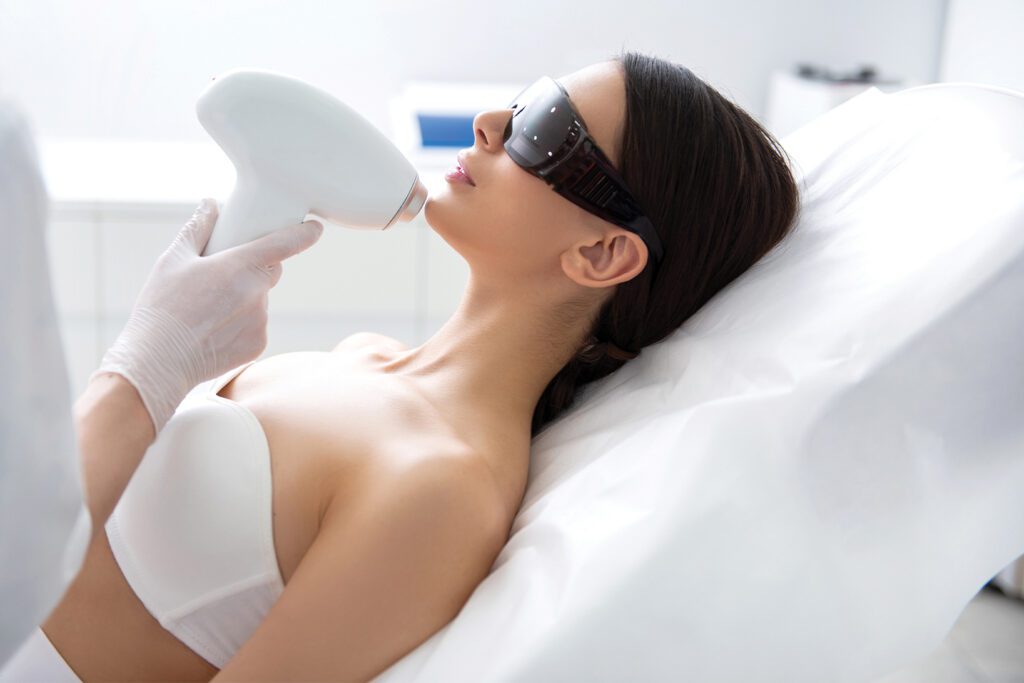Leveraging Lasers
What You Need to Know About the Different Treatment Types
Although we’ve all heard of laser hair removal, that might be where your familiarity with cosmetic laser treatments stops. But lasers aren’t just used for stopping unwanted hair growth at the source – they can aid in diminishing fine lines and wrinkles, banishing pigmented lesions, and weakening acne scars. Here, we shed some light on the different laser treatments and the skin conditions they tackle head-on.
What Are Laser Treatments?
Before diving into which laser treatments do what, you might be wondering how they work. Laser is an acronym for light amplification by stimulated emission of radiation. In layman’s terms, a laser is a source of high energy light that utilizes a single color or wavelength and transmits light onto a very focused area. In cosmetic settings, the light is used to produce heat, which destroys the undesirable skin condition in question.
What Are the Different Types, and What Do They Treat?

When it comes to laser treatments, there are two basic types: ablative and non-ablative. Ablative lasers vaporize the top layer of damaged skin, while non-ablative lasers penetrate deeper into the skin without removing the top layer. From there, options abound, but there are still several main types.
CO2 Lasers
Typically ablative lasers, CO2 lasers use carbon dioxide to create an infrared beam of light. They are among the most popular because the energy they generate is absorbed well by water-dense body tissue. With high precision and few side effects, these lasers are commonly used to treat scars, warts, wrinkles, and conditions set deeper in the skin.
IPL (intense pulsed light)
Though technically not a laser, this treatment uses strong strobes or pulses of light to penetrate skin discoloration. IPL is generally used to banish red or brown spots, as well as break up inflamed blood vessels just below the skin’s surface.
Fractional Lasers
Fractional lasers work by breaking up the laser’s energy into thousands of smaller beams, which create deep, narrow columns of clotting skin tissue. The subsequent healing process results in fast growth of new, healthy tissue, making this a prime treatment for age-related blemishes.
Erbium Lasers
Erbium lasers, which can be either ablative or non-ablative, are primarily used to promote collagen remodeling, which helps keep skin healthy. For this reason, they are often used to treat skin’s laxity, age spots, wrinkles, and fine lines.
Pulsed Dye Lasers
These typically non-ablative lasers use a yellow wavelength and utilize heat to absorb skin colorations and reduce coloration. Pulsed dye lasers are different from IPL treatments in a variety of ways, but primarily in that they use an organic dye that is included in the lasing medium.
ND:YAG Lasers
This laser (which stands for neodymium-doped yttrium aluminum garnet, in case you were wondering) is frequently used by experts to reach a much deeper layer of tissue and tackle conditions such as birthmarks, tattoo, and hair removal.


What Can You Expect?
If you think a laser treatment might be right for you, there are some additional things you should know.
Since laser-treated skin is even more sensitive to sun than normal, many experts recommend getting a treatment in the fall or winter months when days are shorter and cooler temperatures are more likely to keep you inside.
With most non-ablative procedures, patients can expect little to no pain and no downtime. Ablative treatments, on the other hand, can cause some discomfort, and deeper procedures may require sedation. It’s also common with ablative procedures for your skin to be raw and scab over for several weeks as it heals.
When discussing your treatment with a specialist, be upfront and honest about all the medications or supplements you’re taking, as they can affect the outcome of your procedure or healing process.
While some conditions can achieve the desired effect after just one session, most laser treatment plans call for a series of visits. But once the series is complete, results tend to be long-lasting! HS

